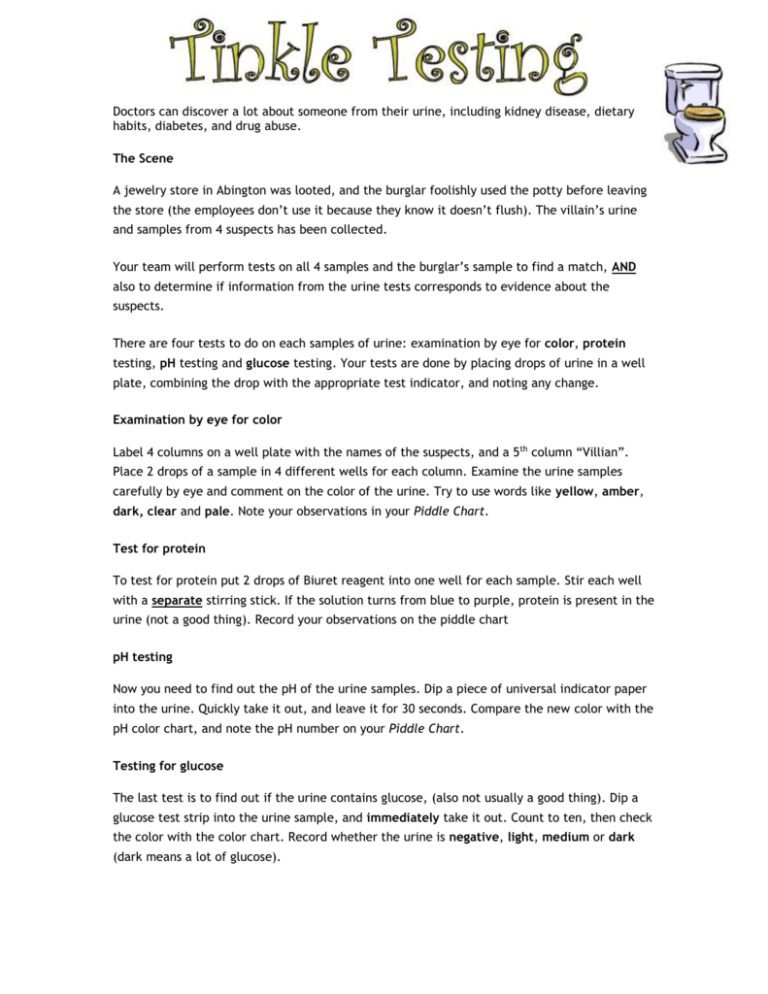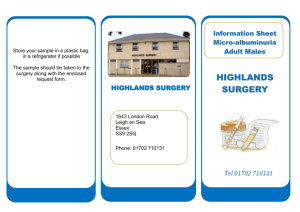Doctors can discover a lot about someone from their urine, including
advertisement

Doctors can discover a lot about someone from their urine, including kidney disease, dietary habits, diabetes, and drug abuse. The Scene A jewelry store in Abington was looted, and the burglar foolishly used the potty before leaving the store (the employees don’t use it because they know it doesn’t flush). The villain’s urine and samples from 4 suspects has been collected. Your team will perform tests on all 4 samples and the burglar’s sample to find a match, AND also to determine if information from the urine tests corresponds to evidence about the suspects. There are four tests to do on each samples of urine: examination by eye for color, protein testing, pH testing and glucose testing. Your tests are done by placing drops of urine in a well plate, combining the drop with the appropriate test indicator, and noting any change. Examination by eye for color Label 4 columns on a well plate with the names of the suspects, and a 5 th column “Villian”. Place 2 drops of a sample in 4 different wells for each column. Examine the urine samples carefully by eye and comment on the color of the urine. Try to use words like yellow, amber, dark, clear and pale. Note your observations in your Piddle Chart. Test for protein To test for protein put 2 drops of Biuret reagent into one well for each sample. Stir each well with a separate stirring stick. If the solution turns from blue to purple, protein is present in the urine (not a good thing). Record your observations on the piddle chart pH testing Now you need to find out the pH of the urine samples. Dip a piece of universal indicator paper into the urine. Quickly take it out, and leave it for 30 seconds. Compare the new color with the pH color chart, and note the pH number on your Piddle Chart. Testing for glucose The last test is to find out if the urine contains glucose, (also not usually a good thing). Dip a glucose test strip into the urine sample, and immediately take it out. Count to ten, then check the color with the color chart. Record whether the urine is negative, light, medium or dark (dark means a lot of glucose). Emily Mario Luke Sarah Villain Color Protein? pH Glucose? Use the following information and your notes from our previous class to answer the case questions as a group. Urine Color and Possible Causes Color Diet Light yellow normal Clear alcohol Amber to orange carrots red beets Brown Rhubarb Drugs Disease steroids antibiotics diabetes Gall bladder problems Blood in urine Laxatives or barbiturates (downers) antidepressants Urine Analysis Results and Possible Causes Test result Diet Low pH (<5) High Protein, many juices, alcohol High pH (>8) Rich in Vegetables, dairy Glucose present Following Very large meal Protein Present Regular high protein Liver malfunction Disease Diabetes Anemia (low iron) Diabetes Anemia Tinkle Test Group Names: Emily Mario Luke Sarah Villain Color Protein? pH Glucose? Who do you think was the likely suspect? Explain your reasons (pee analysis and alibi) What further evidence could you gather from a location other then the jewelry store that would confirm the suspect’s guilt (assume the jewels are hidden away)? Some of the original suspects have been cleared by the urine analysis, but their urine shows possibly serious medical conditions. Identify 2 suspects with abnormal urine and describe what might be wrong with them.







